Commercially, sweet oranges are important for producing palatable juice. Indented glands cover the green-yellow to orange skin of the fruit, which has segmented pulpy flesh and several seeds. White flowers can be found in clusters or singly on the tree. Orange trees can reach a height of 6 to 15 meters and live for over a century.
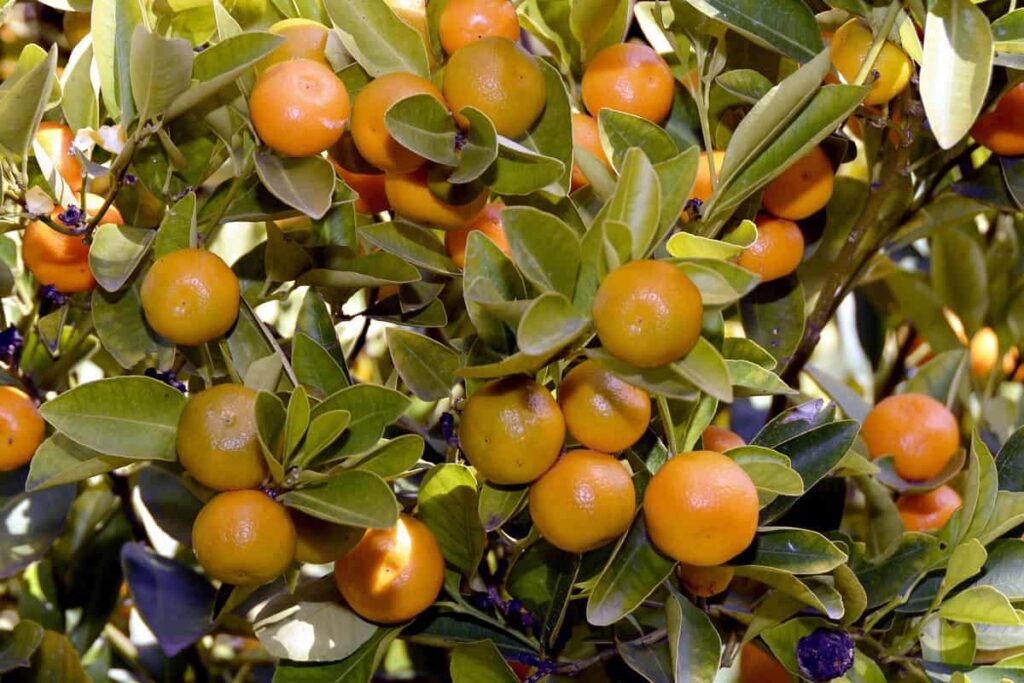
Around 30 years is the average economic lifespan of a plantation. In India, 250 species of insects and mites have been reported infesting different citrus species. Citrus butterflies, leaf miners, blackflies, whitefly, psylla, scales, etc., are the primary pests that cause severe damage to the citrus crop. Most insect pests occur at the new flush stage and damage the new growth, thereby hampering plant development.
Simultaneously, several common diseases can affect citrus trees and are caused by fungi, bacteria, or pests. Protecting orange trees from diseases that can kill and spoil the fruit is essential. Keep an eye on your orange trees for signs that they are sick. A disease can be diagnosed and managed more quickly when you know its symptoms.
How to control pests and diseases in oranges
Pests in Oranges
Citrus Psylla
This pest is a vector for spreading the citrus greening disease. Both the adults and nymphs of this pest suck the sap from the tender parts of the buds, leaves, and branches and inject a toxic substance into them. The larvae excrete white crystalline waxy pellets on which black sooty mold may develop, reducing the photosynthetic area. In a severe attack, leaves get distorted, curled up, and ultimately fall, resulting in complete defoliation of the plant.
Damage symptoms
- The leaves are conspicuously pitted, the pits opening the lower leaf surface.
- In severe attacks, young blades are cupped or otherwise distorted and yellow.
- Leaves with many picks tend to curl upwards.
- Citrus psyllid causes serious problems by transmitting a bacterium causing greening disease.
- Narrowing of leaves, and leaves stand upright with plant dieback.
- The plants become less productive, and fruits are underdeveloped.
- The disease is mainly spread by scion or bud materials.
Biological control
- Lacewings were the other significant predator of the nymphal colonies.
- Pruning off infected branches can slow disease development.
- Some natural enemies, such as species of coccinellids and ladybird beetles, attack the nymphs of citrus psylla.
Chemical control and management
- The pest can be satisfactorily checked by spraying the plants with Phosphamidon (0.025%) and Parathion (0.025%).
- Apply Monocrotophos (0.025%), Malathion (0.03%), or Dimethoate (1.5%) is helpful during March and again in the first week of September. The time of application may be adjusted with the appearance of the pest.
In case you missed it: Top 19 Steps/Ways to Boost Orange Yield: How to Increase Fruit Production, Size, and Quality
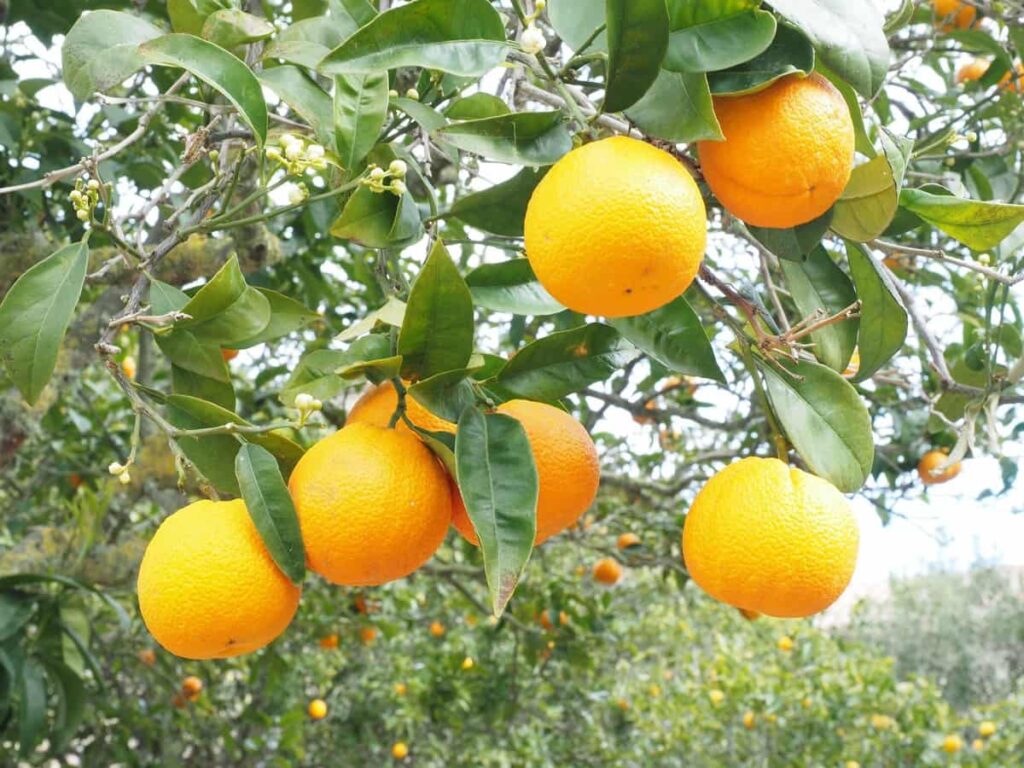
Citrus Leaf miner, Phyllocnistis citrella
This pest causes damage both in the nursery and in the grown-up stages of the citrus plant. Leaf miners attack succulent new growth and avoid fully developed older leaves. The pests are generally considered nuisances on established citrus trees and do not affect the tree’s health enough to warrant control.
During the early stages of the growth of new trees, however, extensive damage from this pest can dramatically reduce their active leaf area, setting them back considerably. It is therefore recommended to protect young trees. Unfortunately, the attack of this pest also encourages the development of citrus canker disease.
Damage symptoms
- The adult moth deposits tiny eggs on the lower surface of the leaf.
- Upon hatching, the larva enters the leaf, where it remains until maturity.
- It then comes out of the leaf and forms a pupation cell by folding over a part of the leaf margin.
- The larvae sometimes mine in between the upper and lower surfaces,
- The serpentine mine is characteristic and conspicuous.
- As a result of the leaf-mining, the lamina weakens and curls.
Biological control
- Pruning all the affected parts during winter should be done to keep the pest population under check.
- Citrus leaf miners have natural enemies, including parasitic wasps that lay eggs in the leaf miner’s tunnels or into the larvae.
- Lady beetles, lacewings, and several other generalist predators also target citrus leafminer (CLM), scales, mealybugs, aphids, and mites. As a result, they help to keep several species of pests at lower levels that are not as damaging.
Chemical control
- Spraying the plants with Methyl Demeton (0.03%) and Phosphamidon (0.035%) at the emergence of new leaves is highly beneficial.
- Applying Phorate 10 G (2.5 kg a.i./ha) applied one day before planting reduces the larval population of leaf miners effectively.
Aphids
An aphid is a tiny, sap-sucking insect with a soft body. Aphids are found all over the world in thousands of species. However, temperate climates like ours are the most suitable for aphid infestations. Aphids are typically pear-shaped and come in a variety of colors. Aphids may be grey, green, white, yellow, black, or red, depending on their species and food source.
Damage symptoms
- Severe curling and deformation of young leaves
- Stunted growth of leaves and twigs
- Some branches and twigs show dieback symptoms
- There is impairment of leaf functionality from the presence of sooty mold fungus, which grows in copious quantities of honeydew excreted by the aphids
Biological control
- Among the most important natural enemies are parasitic wasps that lay their eggs inside aphids.
- Many predators also feed on aphids. The most well-known are lady beetle adults and larvae, lacewing larvae, soldier beetles, and syrphid fly larvae. Naturally occurring predators work best, especially in garden and landscape situations.
In case you missed it: Orange Farming Project Report, Cost and Profit
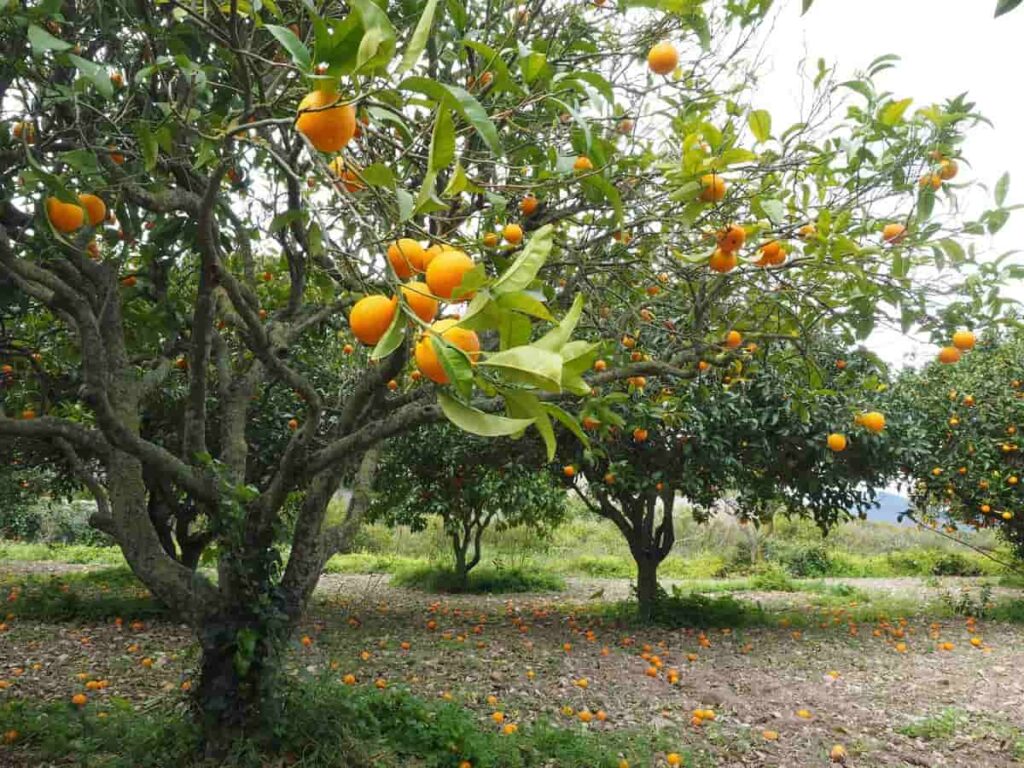
Chemical control
- The population of this pest on citrus can be easily controlled by spraying the plants with Parathion (0.03%) and Malathion (0.03%).
- Also, Monocrotophos (0.025%) or Phosphamidon (0.035%) effectively controls this pest. Therefore, spraying should be immediately undertaken as soon as the problem is observed and the conservation of coccinellid populations.
Citrus Thrips
They are small, orange-yellow, and have fringed wings. In spring and summer, females lay 250 eggs in new leaf tissue, young fruit, or green twigs. The last growth flush of the season is when overwintering eggs are laid. In the spring, about the time of the new growth in the trees, these eggs will hatch. Young larvae are very small, whereas older larvae are spindle-shaped and wingless, about the size of adults. A thrip’s larval stage does not feed and completes its development on the ground. As adults emerge from the tree foliage, they move actively.
Symptoms
- Scabby, grayish, or silvery scars are left on young, immature leaves and fruits by adults and larvae.
- Due to their feeding habits, old larvae cause the most damage to young fruits.
- As the fruit grows, the damaged rind extends outward from beneath the sepals and becomes a visible scar.
- Fruits are most susceptible to damage from shortly after petal fall until they are about 3.7 cm in diameter.
Biological control
- Among the predatory mites attacking citrus thrips are Euseius tularensis, spiders, lacewings, and minute pirate bugs. This species is an indicator species and provides control of the pest. Additionally, it indicates the level of natural enemies present in an orchard. Therefore, pesticides should not be used in large quantities to disrupt these predatory species.
- Organically managed orchards usually apply spinosad formulations with oil, kaolin, or Sabadilla alkaloids with molasses or sugar bait.
Chemical control
- Apply cyantraniliprole or spray or inject Monocrotophos at 0.05% throughout the tree.
- Also, the application of a mixture of avermectins containing about 80% avermectin B1a and 20% avermectin B1b keeps thrips under control
Types of diseases in orange trees
Citrus Canker
This disease is caused by the Xanthomonas citri bacterium found in southern Asia. It thrives in moist, warm conditions. As a result of rain, wind, and Asian leaf miner bugs feeding on infected leaves, the disease spreads. Citrus canker can also be caused by contact with pruning equipment and other items that have touched an infected tree. Symptoms of this disease include blemishes on oranges and premature leaf drop (defoliation), which harms trees. Therefore, even the fruit will drop before harvesting is completed.
In case you missed it: Orange Farming, Planting, Growing, Care, Harvesting
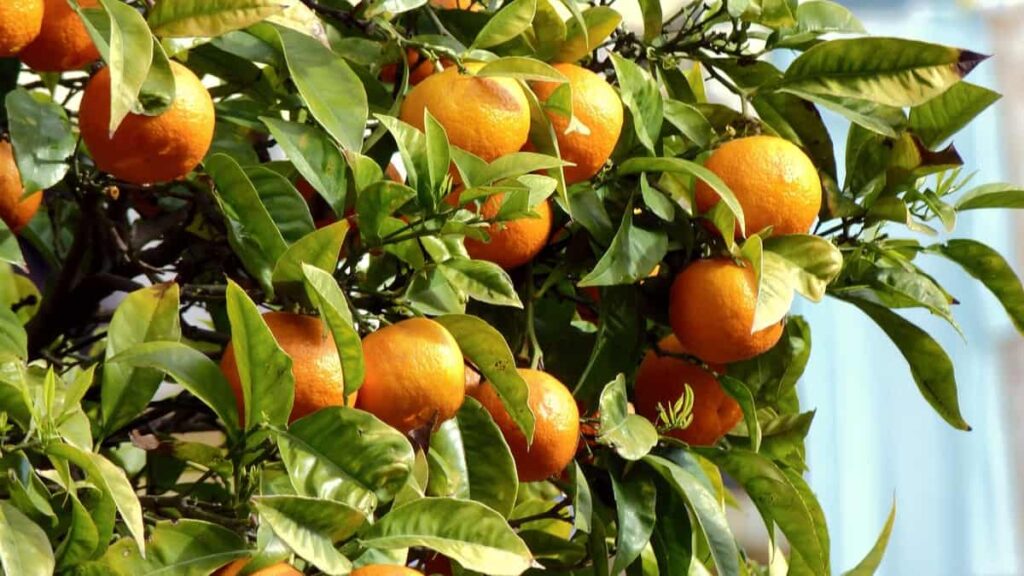
Disease symptoms
- Initially, the disease appears as minute, water-soaked, round, yellow spots that enlarge slightly and turn brown.
- A characteristic yellow halo surrounds these pustules.
- A yellow halo surrounds canker lesions on fruit but not on leaves. A canker may form when several lesions merge on the fruit.
- Due to severe infections, there may be defoliation, and twigs and stems may show dieback symptoms.
Chemical control and management
- Unfortunately, if your orange tree has a citrus canker, you must remove and destroy it to stop the spread.
- Liquid copper fungicide is the best way to prevent citrus canker on orange trees. Applied to the tree’s fruit, foliage, and wood, the spray has a long-lasting effect. When applying the spray to your tree, follow the directions carefully.
Huanglongbing (HLB), or Citrus Greening
Huanglongbing (HLB) is a severe bacterial disease of orange trees. The wedge-shaped Asian citrus psyllid spreads this disease by feeding on the stems. Orange trees are eventually killed by it because it slows down their nutrient intake and stunts their growth and taste.
Disease symptoms
- There are small green islands within the chlorotic areas on the affected leaves.
- Heavy leaf fall may occur with the onset of summer.
- Twig dieback may also occur.
- Affected fruits remain green and give a bitter taste
- Affected fruits show a reduction in size, lopsided growth, and oblique columella.
- Seeds are poorly developed, dark-colored, and aborted
Control methods and management
- For the bacteria not to spread, the infected tree must be removed.
- The Asian citrus psyllid is a significant concern when preventing an orange tree disease like this. Spray trees with cyhalothrin to kill the adults and nymphs. Malathion can also be used.
- Spray the ground around trees with a systemic product like imidacloprid to kill nymphs in the folds of leaves in the canopy. Note, do not use imidacloprid when trees are flowering, as it is toxic to bees.
- As an alternative to synthetic products, use soft insecticides, like horticultural spray oil, neem, or insecticidal soap. These treatments give protection for 9-12 months.
Citrus greasy spot
The citrus greasy spot is a fungal disease spread by wind and rain on orange trees. In summer and humid conditions, the fungus thrives on decomposing leaves and dead sticks at the base of trees. As it spreads throughout the tree and its grove, it defoliates leaves and eventually kills them.
Identifying symptoms
- It may take months for citrus greasy spots to appear. Yellow spots may appear on the top, and brown blisters may appear on the bottom. The spots can also be seen between the oil glands of infected oranges.
- Black lesions with a greasy appearance will develop later in the progression of the disease.
In case you missed it: Greenhouse Farming in South Africa: How to Start, Crops, and Cultivation Practices
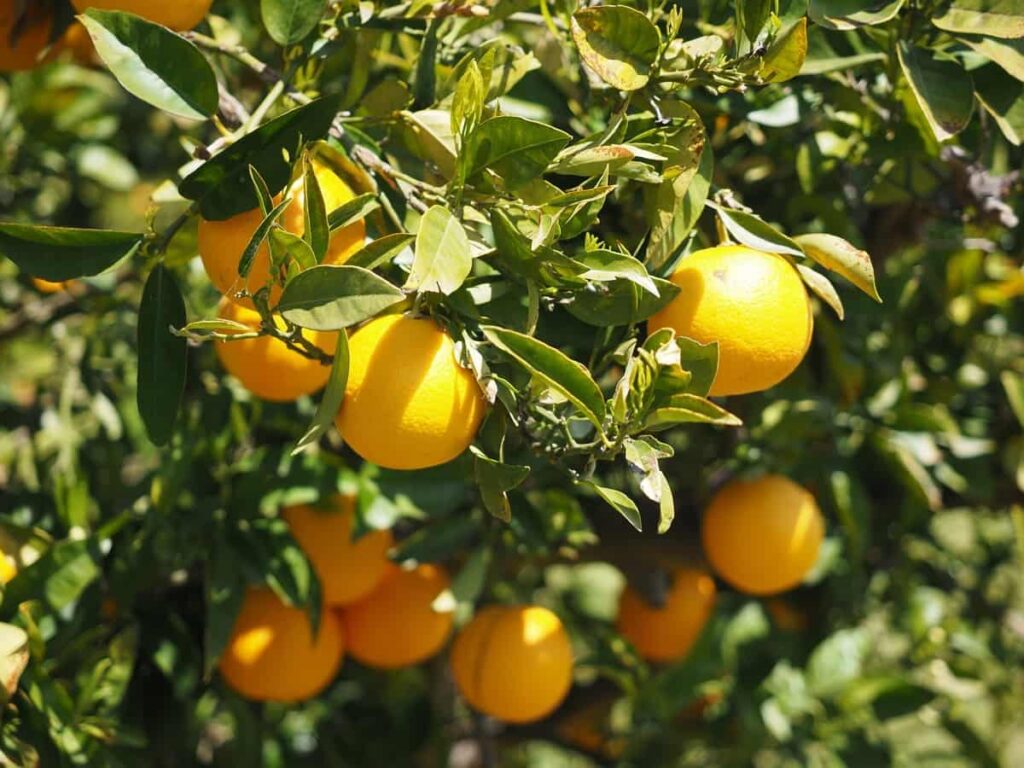
Control methods and management
- Spraying liquid copper fungicide can prevent citrus greasy spots and protect developing oranges from citrus cankers. However, depending on how severe the infection is on the leaves and fruit, you may need to spray again in late summer.
- Your orange tree can also be prevented from spreading the fungus by removing fallen leaves and dead branches. Especially when pruning, it is crucial. Petroleum oil reduces the penetration of the spores into the leaf but does not reduce spore germination. Thus the main action of oil is to minimize greasy spots by preventing or delaying the development of symptoms, even when the pathogen is already established deeply in the leaf.
Citrus Leprosis
Citrus leprosis is caused by the Citrus leprosis virus (CiLV) transmitted by mites in the genus Brevipalpus. A viral orange tree disease, citrus leprosis is spread by false spider mites after feeding on infected leaves. This disease directly reduces production and the life span of the citrus plant. The main symptoms of the disease include lesions on fruits, leaves, and twigs or small branches, causing premature fruit drop and defoliation.
Identifying symptoms
- Citrus canker-like lesions appear round and dark brown with yellow halos where mites have fed. There is a difference in that the lesions do not have raised centers.
- Typical lesions are circular with a dark-brown central feeding spot caused by mites.
- A chlorotic halo surrounds the feeding spot in one to three concentric rings. Coalescing lesions can form larger erratically shaped lesions.
- Lesion centers may crack at high temperatures.
Treating Citrus Leprosis
- The spreaders of an orange tree disease like this must be controlled to treat it. Set up windbreaks, for instance, to prevent spider mites from flying onto your trees.
- Mites can hide beneath cracks in trees, making spraying difficult. Check your trees regularly for mites. Spray them with an insecticide like Neem Oil or a miticide like Horticultural Oil.
- Predators of the vector mites are frequently found in the same environments as the Brevipalpus species.
- Mites of the Phytoseidae family, such as species of the genus Eusebius, Amblyseiu, and Phytoseiulus, are the most important natural enemies of the mite vector B. phoenicis in citrus groves.
- Formulations containing the entomopathogenic fungi of the genus Metarhizium or Hirsutella thompsonii can also be used to reduce populations.
- Formulations of miticides containing the active ingredient Acrinatrin, Azocyclotin, Bifenthrin, Cyhexatin, Dicofol, Hexythiazox, and Fenbutatin oxide are recommended against the mites that carry the citrus leprosis virus.
Citrus Melanose
Melanose is a decomposing organism that completes its life cycle on dead twigs. The severity of the disease is determined by the amount of fungal growth on dead wood and the duration of continuous wetting periods following rainfall or overhead sprinkler irrigation. Around 18-24 hours of wetting and temperatures between 20-24°C are required for infection to occur. Spores cause problems when there are significant amounts of dead wood on trees, on the ground, or in piles of brush left in the grove.
Disease symptoms
- Melanose symptoms occur as reddish-brown to dark-brown specks on fruits at the late stages of maturation.
- The specks form around the oil glands present on the skin. Wound tissue and cracking are expected in the process of infection. As a result, fruits may be stunted and fall prematurely.
- Melanose spots have a sandpaper-like texture when touched. The pathogen causes fruit rot on fully mature fruits, typically developing from the stalk, and may also cause early fruit fall.
- Foliar symptoms appear first as small brown discrete spots that develop into raised pustules impregnated with a reddish-brown gum.
- In addition to the yellow halo, they often form small, hard corky pustules. Stem-end rot may occur under certain storage conditions.
In case you missed it: How to Grow Oranges in USA: Check How this Guide Helps Beginners in Orange Farming
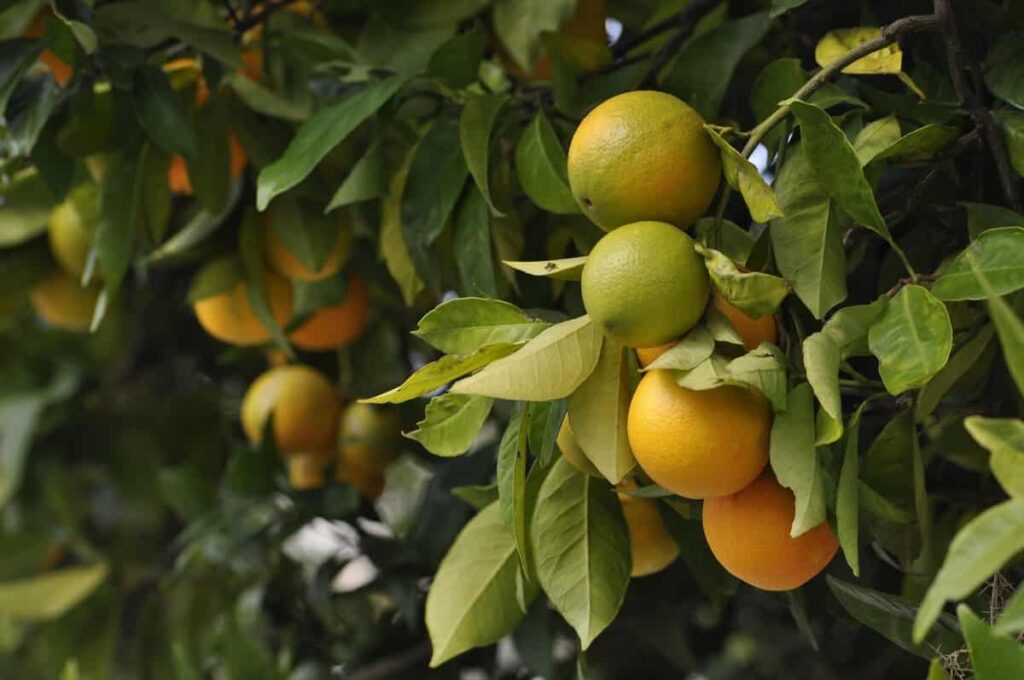
Treating Citrus Melanose
- You should remove any dead or decaying plant material near your orange tree. Pruning a tree should be done with disinfected tools, and overhead watering should be avoided.
- You can apply copper fungicide to an infected tree by following the instructions on its bottle. The copper sprays act as protectants, preventing infection of the young developing fruit.
- Applying pyraclostrobin during the spring flush growth has been proven effective against the development of melanose on fruits.
- Products based on mancozeb and fenbuconazole are also recommended. Strobilurin fungicides have also given satisfying results and may also be applied.
Citrus Psorosis
A viral orange tree disease, citrus psorosis is spread through infected bud grafts, grafting tools, and seeds. It affects orange trees about eight to ten years old, lessens their lives, and produces fewer oranges. It is another orange tree disease that may be asymptomatic, being as long as ten years.
Identifying symptoms
- You will see patches of tree bark with small bumps, becoming scaly and forming gummy lesions later.
- Yellow spots and scars will appear on the leaves, and hollow grooves will appear on the fruit rinds.
- Because it causes yellowish rings on the oranges, this disease is inedible, unlike citrus canker or leprosy.
Control methods and management
- The usage of chemical treatments can not directly control virus diseases. When psorosis is present in a grove, disinfection of tools should be practiced by dipping pruning or budding tools in a bleach solution.
- A certified, disease-free bud wood for grafting is the best way to prevent the disease.
- It may be necessary to remove and replace an orange tree with citrus psorosis. Unfortunately, even though scraping away infected bark stalls the disease, the tree won’t produce many good-quality oranges.
Conclusion
There are several pests, diseases, and disorders that can affect the fruit quality as well as the overall yield. Therefore, the damage source must be correctly identified when choosing the best management practice. Using preventative practices is also essential to identify potential sources of damage early since it is often too late to stop it once the damage is discovered.
- Economical Aquaculture: A Guide to Low-Budget Fish Farming
- 15 Common Planting Errors That Can Doom Your Fruit Trees
- How to Make Houseplants Bushy: Effective Tips and Ideas
- Innovative Strategies for Boosting Coconut Pollination and Yield
- Pollination Strategies for Maximum Pumpkin Yield
- The Complete Guide to Chicken Fattening: Strategies for Maximum Growth
- Natural Solutions for Tulip Problems: 100% Effective Remedies for Leaf and Bulb-Related Issues
- Revolutionizing Citrus Preservation: Towards a Healthier, Greener Future
- Natural Solutions for Peony Leaf and Flower Problems: 100% Effective Remedies
- Maximizing Profits with Avocado Contract Farming in India: A Comprehensive Guide
- Natural Solutions for Hydrangea Problems: 100% Effective Remedies for Leaf and Flowers
- The Ultimate Guide to Choosing the Perfect Foliage Friend: Bringing Life Indoors
- From Sunlight to Sustainability: 15 Ways to Use Solar Technology in Agriculture
- The Ultimate Guide to Dong Tao Chicken: Exploring from History to Raising
- The Eco-Friendly Makeover: How to Convert Your Unused Swimming Pool into a Fish Pond
- Mastering the Art of Delaware Chicken Farming: Essentials for Healthy Backyard Flocks
- 20 Best Homemade Fertilizers for Money Plant: DIY Recipes and Application Methods
- How to Craft a Comprehensive Free-Range Chicken Farming Business Plan
- Brighten Your Flock: Raising Easter Egger Chickens for Beauty and Bounty
- How to Optimize Your Poultry Egg Farm Business Plan with These Strategies
- Subsidy for Spirulina Cultivation: How Indian Government Schemes Encouraging Spirulina Farmers
- Ultimate Guide to Raising Dominique Chickens: Breeding, Feeding, Egg-Production, and Care
- Mastering the Art of Raising Jersey Giant Chickens: Care, Feeding, and More
- Ultimate Guide to Raising Legbar Chickens: Breeding, Farming Practices, Diet, Egg-Production
- How to Raise Welsummer Chickens: A Comprehensive Guide for Beginners
- How to Protect Indoor Plants in Winter: A Comprehensive Guide
- Ultimate Guide to Grow Bag Gardening: Tips, Tricks, and Planting Ideas for Urban Gardeners
- Guide to Lotus Cultivation: How to Propagate, Plant, Grow, Care, Cost, and Profit
- Agriculture Drone Subsidy Scheme: Government Kisan Subsidy, License, and How to Apply Online
- Ultimate Guide to Raising Araucana Chickens: Breed Profile, Farming Economics, Diet, and Care
- Bringing Hydroponics to Classroom: Importance, Benefits of Learning for School Students
- Ultimate Guide to Raising Polish Chickens: Breed Profile, Farming Economics, Diet, and Care
- Ultimate Guide to Raising Australorp Chickens: Profile, Farming Economics, Egg Production, Diet, and Care
- Silkie Chicken Farming: Raising Practices, Varieties, Egg Production, Diet, and Care
- Sussex Chicken Farming: Raising Practices, Varieties, Egg Production, Diet and Care
- Homemade Feed Formulations for Livestock: Discover Cost-effective Starter to Finisher Feed Recipes